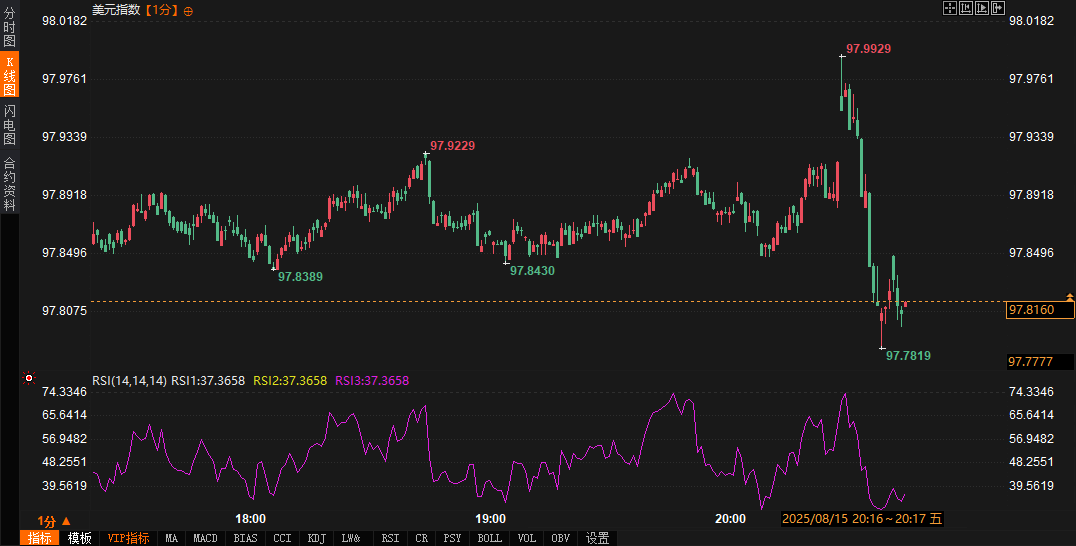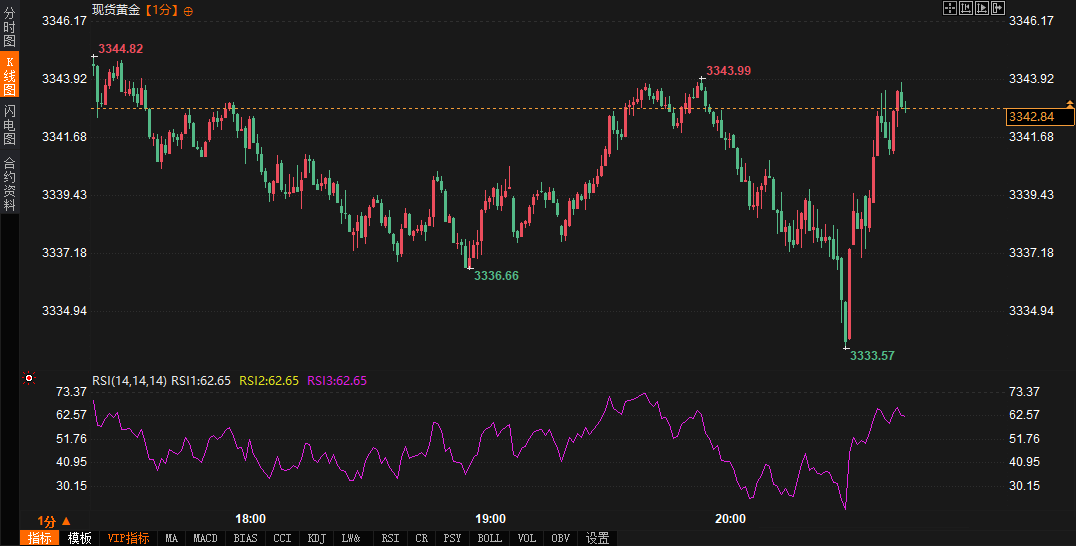Retail sales met expectations but showed a fatal flaw, with gold's $3,333 support under attack! September rate cut bets backfired!
2025-08-15 20:56:26

Market Background and Data Overview
Entering 2025, the US economy is navigating a complex landscape of inflationary pressures and monetary policy expectations. The Consumer Price Index (CPI) remained steady at 2.7% in July, but the Producer Price Index (PPI) surged 0.9% month-over-month, the largest increase since June 2022, raising market concerns about a resurgence in inflation. Federal Reserve Chairman Powell previously emphasized that consumer spending is a core indicator for setting interest rate policy, and retail sales, as a key barometer of consumer spending, directly influence market bets on a September Fed rate cut. Prior to the release of July retail sales data, the consensus forecast was a 0.5% month-over-month increase, slightly lower than June's 0.6%. Core retail sales (excluding automobiles, gasoline, building materials, and food services) were expected to grow 0.3%, a slight slowdown from the previous reading of 0.5%. The actual data, released after the release, largely met expectations, indicating that consumer momentum remains robust, but potential risks should not be ignored.
Immediate market reaction: Increased volatility in the US dollar and bond markets
The market reaction to the release of July retail sales data was swift but mixed. The US dollar index (DXY) briefly rose over 10 points to 97.95, reflecting a positive interpretation of the consumption data as meeting expectations. However, the Bloomberg Dollar Spot Index subsequently pared its losses, suggesting that market sentiment was not entirely optimistic. Spot gold briefly fell by about $5, hitting a low of $3,333.57 per ounce before rebounding.


S&P 500 futures continued their modest gains, indicating cautious optimism among investors about consumer resilience. Meanwhile, the U.S. Treasury market saw volatility, with the 10-year Treasury yield rising 0.9 basis points to 4.302%, while the two-year Treasury yield remained flat at 3.742%. The yield curve remained positive at 55.8 basis points, indicating that market confidence in the short-term economic outlook remained relatively stable.
However, short-term interest rate futures prices fell, and traders' bets on a September Fed rate cut have retreated slightly. Previously, the market had pegged the probability of a 25 basis point cut at 93%. However, after the data was released, some traders began to reassess the potential constraints of inflationary pressures on the pace of rate cuts. This reaction is closely related to the unexpectedly strong July PPI data, which has raised market concerns that price pressures on producers could gradually filter through to consumers, pushing up CPI.
Institutional interpretation: Consumption resilience and inflation concerns coexist
Interpretations of July's retail sales data focused on the balance between consumer resilience and inflation risks. Analysts from leading institutions noted that the 0.5% month-over-month increase in retail sales was primarily driven by strong sales of motor vehicles and parts, as well as efforts by retail giants like Amazon and Walmart to stimulate consumption by extending promotional periods (e.g., Amazon Prime Day from 48 hours to 96 hours). Electric vehicle sales saw a particularly strong increase, driven in part by a rush to buy ahead of the expiration of federal tax credits on September 30th. However, this consumer momentum conceals structural divergences: middle- and upper-income households are the primary drivers of spending, while lower-income households face pressure from slowing wage growth and reduced work hours.
Statements from Federal Reserve officials further underscored the importance of the data. Chicago Fed President Goolsbee called the latest PPI and CPI data "disturbing," but emphasized the need to observe more inflation data to determine whether the economy remains on the "golden path" for rate cuts. Institutions generally believe that while July's retail sales data was robust, it was insufficient to alter the baseline expectation of a September rate cut. In contrast, the unexpected surge in PPI and the 0.4% month-over-month increase in the import price index (the largest increase in 15 months) heightened market concerns about rising inflation. Leading analysts suggest that if inflationary pressures persist, the Fed may slow the pace of rate cuts, or even pause them in the second half of 2025, to address potential stagflation risks.
Institutional views reflect similar divergences. TMResearch noted that while retail sales data met expectations (0.5% vs. 0.6% expected), core retail sales (excluding autos and gasoline) grew only 0.2%, down from the previous reading of 0.6%, suggesting a possible slowdown in consumer momentum. TD Securities analysts projected a 0.6% increase in control group retail sales, exceeding market consensus, but the overall data still showed signs of demand weakness. These interpretations suggest that institutions are cautious about any positive short-term reaction to the consumer data, focusing more on the implications of inflation and labor market data for future policy.
Retail investor interpretation: Optimism and risk aversion intertwined
Retail investors' reactions to the retail sales data were polarized. Some were optimistic that the data met expectations, believing that resilient consumption provided support for the stock market. For example, one user commented, "Retail sales are stable, the S&P 500 can still surge, don't panic about tech stocks!" This reflected their hope that the consumption data would boost market confidence. However, other investors expressed concerns about inflationary pressures and tariff talk. Some traders suggested that the unexpectedly strong growth in the Producer Price Index (PPI) in July could signal short-term stagflation risks. While the retail sales data met expectations, the 0.5% increase, lower than the 0.9% in June, suggests a potential decline in spending power. Retail investors also noted the diverging consumption patterns reflected in bank credit card data. Some noted that US bank data showed an unexpected surge in personal consumption expenditures in July, but the limited spending power of low-income households could lead to a rise in personal bankruptcies in the future.
Compared to pre-data expectations, retail investor sentiment has adjusted somewhat. Prior to the data release, some investors, based on the strong performance of the PPI in June and the boost from Amazon promotions, predicted that July retail sales might exceed expectations by 0.6%-0.8%. After the data was released, the actual 0.5% growth, while in line with expectations, fell short of some optimistic predictions, shifting market sentiment from a "chase for the high" to a "wait-and-see" approach. Retail investors have also become more cautious in their discussion of Federal Reserve rate cuts, with some users suggesting that inflationary pressures could force the Fed to delay rate cuts until the second half of 2025.
Impact on Fed rate cut expectations and market trends
The release of July retail sales data had a subtle impact on expectations for a Federal Reserve rate cut. The data met expectations, demonstrating that consumer spending remains resilient in a high-interest environment, supporting the market consensus for a 25 basis point rate cut in September. However, unexpected increases in producer price inflation (PPI) and import prices cast a shadow on the path of rate cuts. The market generally expects the Fed to initiate rate cuts in September, but the pace of subsequent cuts will depend on the evolution of inflation data. If the CPI rises further in August, the Fed may favor a more cautious pace of monetary easing, or even pause rate cuts in the second half of 2025 to counter inflationary pressures.
Market trends suggest that the modest rise in S&P 500 futures following the release of retail sales data reflects investor confidence in consumer resilience, but fluctuations in the US dollar index and Treasury yields suggest growing concerns about inflation. In the short term, tech and consumer goods sectors are likely to gain support from robust consumer data, but high valuations (the S&P 500's price-to-earnings ratio exceeds 24 times) may limit upside. In contrast, safe-haven assets such as gold may be in demand due to rising inflation expectations and uncertainty surrounding the Russia-Ukraine situation.
Future Trend Outlook
Looking ahead, solid retail sales data provides short-term support for the US economy, but uncertainty about the consumer outlook is growing. A weak labor market and rising commodity prices are likely to curb consumption growth in the third quarter, with a particularly significant impact on low-income households. The Federal Reserve's policy path will be a key focus for the market. If August's CPI continues the trend of exceeding expectations following July's PPI, expectations for rate cuts could further cool, and the US dollar index and Treasury yields could continue to rise, suppressing stock market valuations.
For investors, the current market environment requires a balance between optimism and caution. In the short term, consumer and technology sectors may remain attractive due to consumer resilience, but caution should be exercised against market volatility triggered by inflationary pressures and tariff rhetoric. Longer-term, increasing consumer divergence could lead to a slowdown in economic momentum. Investors should monitor upcoming inflation data and comments from Federal Reserve officials, adjusting positions and increasing cash reserves to mitigate potential volatility. Discussions among institutional and retail investors indicate that the market's interpretation of consumer data will continue to influence the performance of risky assets. Investors should remain flexible and closely monitor dynamic changes in economic data.
- Risk Warning and Disclaimer
- The market involves risk, and trading may not be suitable for all investors. This article is for reference only and does not constitute personal investment advice, nor does it take into account certain users’ specific investment objectives, financial situation, or other needs. Any investment decisions made based on this information are at your own risk.





















